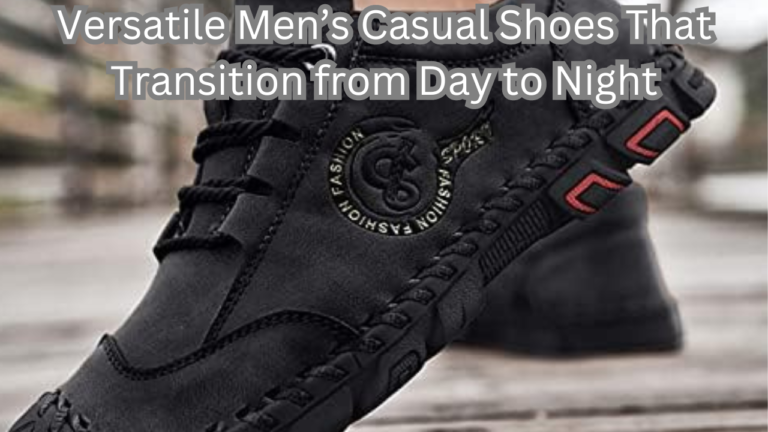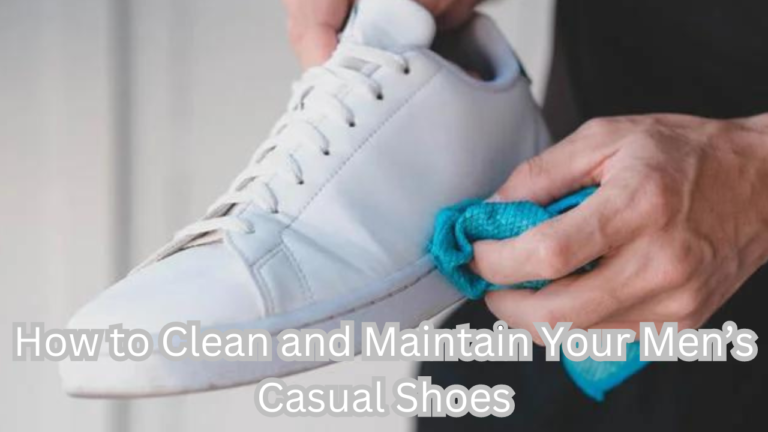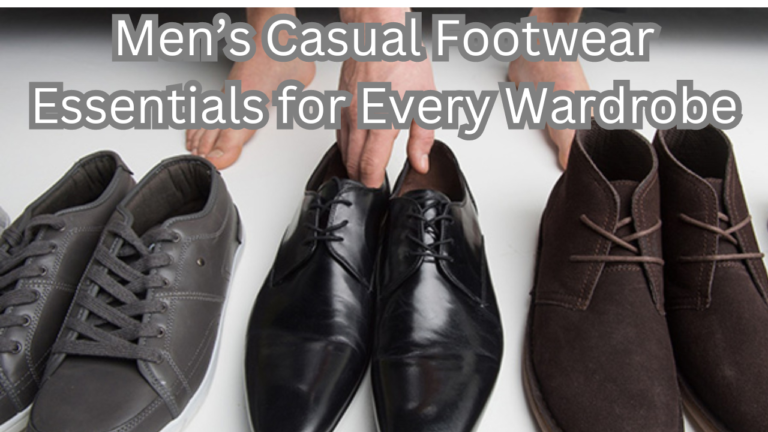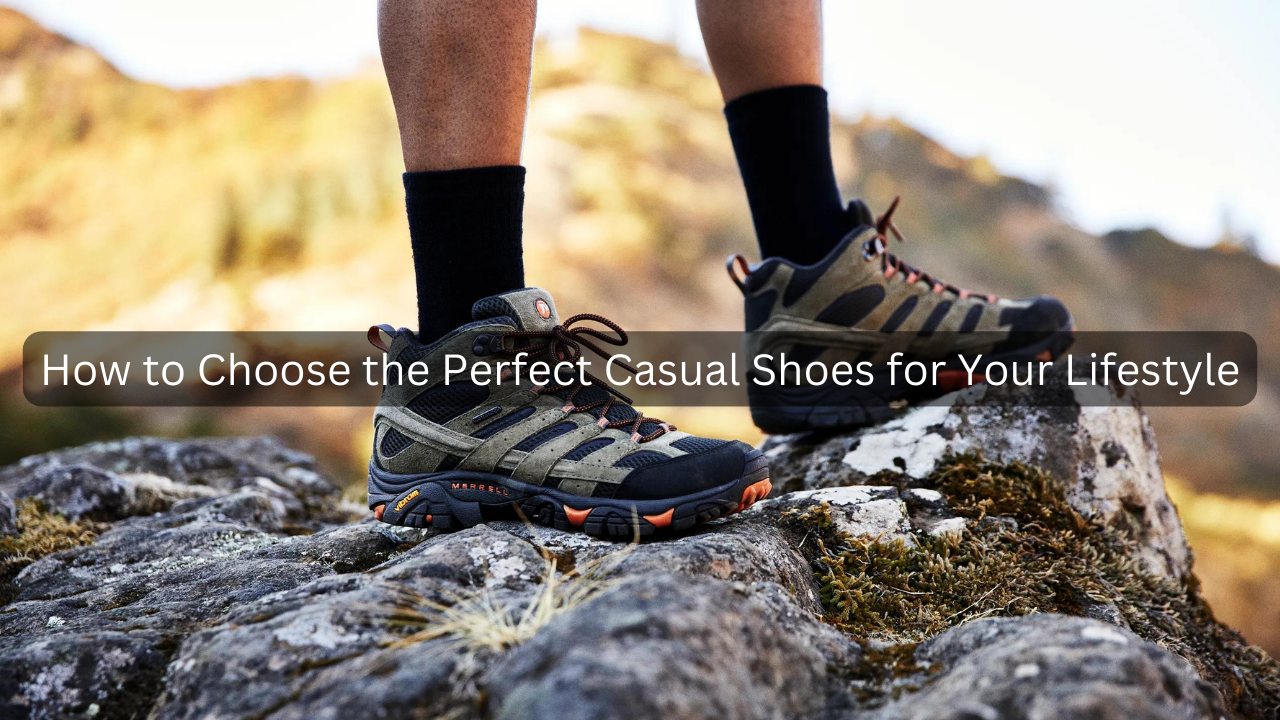
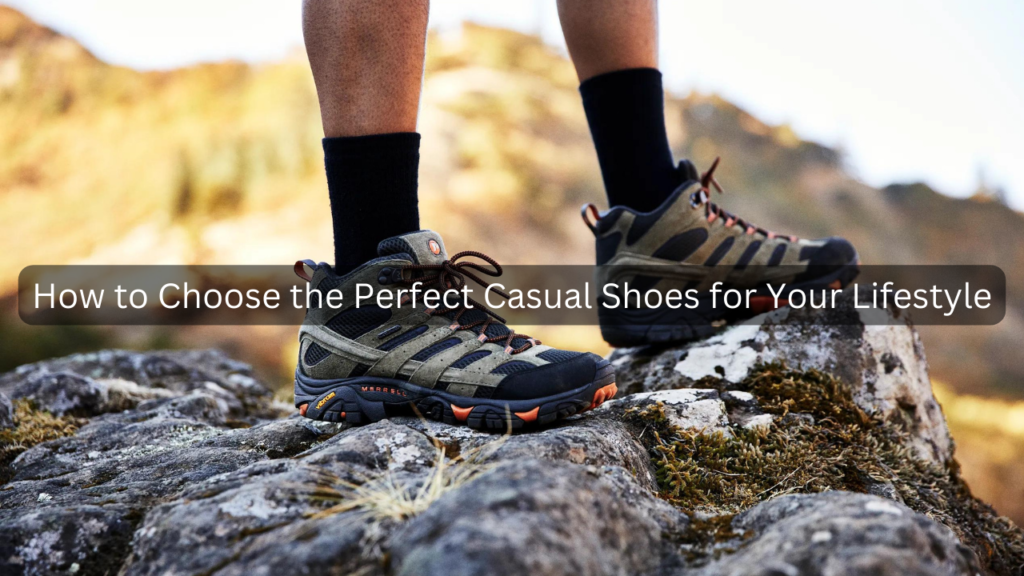
Table of Contents
Introduction
Casual shoes are more than just footwear—they’re a reflection of your style, comfort, and practicality in everyday life. Whether you’re navigating city streets, relaxing with friends, or heading to work, the right pair of casual shoes can make all the difference. In this guide, we’ll explore essential factors to consider when selecting the perfect casual shoes tailored to your lifestyle. From comfort and style to durability and weather suitability, understanding these elements will help you find shoes that not only look great but also support your feet through every step of your day. Let’s dive into the art of choosing casual shoes that seamlessly blend fashion with function.
Importance of Choosing the Right Casual Shoes
Casual shoes play a crucial role beyond mere fashion—they are essential for comfort, support, and overall well-being throughout your daily activities. The right pair can enhance your posture, reduce fatigue, and provide necessary cushioning for your feet. Whether you’re strolling through the city, attending casual gatherings, or running errands, well-chosen casual shoes can make every step more enjoyable and effortless.
Overview of Factors to Consider
When selecting the perfect casual shoes, several key factors should guide your decision-making process:
- Comfort: Prioritize shoes that offer cushioned insoles, adequate arch support, and a fit that allows for natural movement.
- Style: Choose a style that complements your personal taste and fits seamlessly into your wardrobe for various occasions.
- Durability: Look for shoes made from quality materials with strong stitching and durable soles to withstand daily wear and tear.
- Versatility: Opt for shoes that can be easily paired with different outfits and suitable for a range of activities.
- Fit: Ensure the shoes fit properly, providing enough room for your toes and no uncomfortable pressure points.
- Weather-appropriateness: Consider materials that suit your local climate, whether it’s waterproof features for rainy days or breathable fabrics for warmer weather.
By considering these factors, you can choose casual shoes that not only look stylish but also support your lifestyle with comfort and durability.
Comfort
Comfort is paramount when selecting casual shoes, as it directly impacts your daily comfort and overall foot health.
Importance of Comfort in Casual Shoes
Casual shoes that prioritize comfort contribute significantly to your well-being throughout the day. They minimize foot fatigue, provide support where needed, and allow for natural movement, enhancing your overall walking experience.
Features to Look For:
- Cushioned Insoles: Opt for shoes with ample cushioning in the insoles. This feature absorbs impact and provides a plush feeling underfoot, reducing strain on your feet and joints.
- Arch Support: Look for shoes that offer adequate arch support. This helps maintain the natural shape of your arches, prevents overpronation or supination, and enhances overall foot stability and comfort.
- Breathable Materials: Choose shoes made from breathable materials such as mesh, canvas, or certain types of leather. Breathable shoes allow air circulation, keeping your feet cool, dry, and comfortable, particularly in warmer climates or during extended wear.
By prioritizing these comfort features, you can ensure that your casual shoes not only look good but also provide the support and comfort necessary for your daily activities.
Style
Your personal style is a key factor when choosing casual shoes, as they are a reflection of your individuality and fashion preferences.
Consider Your Personal Style
When selecting casual shoes, it’s essential to consider how they align with your personal style. Whether you prefer a sporty, classic, or contemporary look, your shoes should complement your overall aesthetic and enhance your wardrobe.
Types of Casual Shoes:
- Sneakers: Versatile and comfortable, sneakers come in various styles from athletic designs to casual streetwear. They are perfect for everyday wear and can be dressed up or down depending on the occasion.
- Loafers: Loafers are slip-on shoes known for their classic and sophisticated appeal. They are easy to wear and can be styled with both casual and semi-formal outfits, making them a versatile choice for many occasions.
- Boat Shoes: Typically made of leather or canvas with a non-marking rubber sole, boat shoes are casual yet stylish. They are designed for comfort and are particularly popular for summer or maritime-themed outfits.
- Others: Other types of casual shoes include:
By understanding these different types of casual shoes and considering your personal style preferences, you can choose shoes that not only fit comfortably but also complement your unique fashion sense.
Durability
Choosing durable casual shoes ensures they can withstand daily wear and provide long-lasting comfort and support.
Importance of Durable Materials and Construction
The durability of casual shoes is crucial for their longevity and performance. High-quality materials and solid construction contribute to shoes that maintain their shape, comfort, and appearance over time.
Materials to Consider:
- Leather: Leather is a durable and timeless material that molds to your feet over time, offering both comfort and longevity. It resists wear and tear and can be polished to maintain its appearance.
- Canvas: Canvas shoes are lightweight and breathable, making them ideal for warmer weather. While not as rugged as leather, canvas shoes are often treated for durability and can be washed to keep them looking fresh.
Sole Durability and Traction
In addition to the upper material, consider the durability of the shoe’s sole:
- Sole Durability: Look for shoes with sturdy soles made from materials like rubber or synthetic compounds. These provide shock absorption and withstand abrasion from daily use.
- Traction: A well-designed outsole with good traction is essential for stability and safety, especially on slippery surfaces. Look for patterns or grooves that enhance grip and prevent slipping.
Choosing casual shoes with durable materials and robust construction ensures they not only look good but also stand up to the rigors of your daily activities, offering lasting comfort and reliability.
Versatility
Versatility in casual shoes allows them to seamlessly integrate into various outfits and occasions, maximizing their utility and style.
Choosing Shoes That Match Multiple Outfits
Opting for versatile casual shoes simplifies your wardrobe choices and ensures you’re always ready for different occasions:
- Neutral Colors: Choose shoes in neutral colors like black, brown, gray, or navy. These hues complement a wide range of clothing styles and colors, making them easy to pair with multiple outfits.
- Classic Styles: Select shoes in classic styles such as simple sneakers, loafers, or boat shoes. These timeless designs transcend seasonal trends and can be dressed up or down depending on the occasion.
Colors and Styles That Are Versatile
Consider the following when selecting versatile casual shoes:
- Casual Outings: Sneakers or loafers in neutral colors are perfect for everyday activities such as shopping, hanging out with friends, or running errands.
- Work Settings: Depending on the dress code, loafers or leather sneakers in darker tones can be suitable for casual work environments where comfort is key.
- Social Gatherings: Boat shoes or stylish sneakers can be paired with jeans or chinos for casual gatherings or weekend outings.
By choosing casual shoes that are versatile in color and style, you ensure they effortlessly complement different outfits and occasions in your daily life, enhancing both your comfort and fashion flexibility.
Fit
Achieving the proper fit in casual shoes is essential for ensuring comfort, foot health, and overall satisfaction with your footwear.
Importance of Proper Fit for Comfort and Foot Health
A well-fitted shoe not only feels comfortable but also supports the natural contours of your feet, reducing the risk of discomfort, blisters, and foot problems over time.
Tips for Ensuring a Good Fit:
- Toe Room: Make sure there is enough space in the toe box for your toes to wiggle comfortably. Your toes should not feel cramped or squeezed together. Aim for about a half-inch of space between your longest toe (usually the big toe) and the end of the shoe.
- No Pinching or Rubbing: Walk around in the shoes to ensure there are no areas where the shoe pinches or rubs against your feet. Pay attention to the sides, heels, and top of the shoe. Shoes that pinch or rub can cause blisters and discomfort.
- Try Different Sizes: Sizes can vary between brands and styles, so try on different sizes to find the best fit. Your feet may also change size over time, so it’s important to measure both feet and try shoes on both.
- Consider Width: Some shoes come in different widths (e.g., narrow, regular, wide). Choose a width that accommodates the natural width of your feet without squeezing or feeling too loose.
- Arch Support: Ensure that the shoe provides adequate support for your arches. This helps maintain proper alignment and reduces strain on your feet and ankles.
By prioritizing these fit considerations, you can ensure that your casual shoes fit comfortably and properly, promoting both foot health and overall well-being throughout your daily activities
Weather-Appropriate
Choosing casual shoes suitable for the climate and weather conditions ensures comfort and practicality in varying environmental settings.
Consideration of Climate and Weather Conditions
Understanding your local climate helps in selecting shoes that provide adequate protection and comfort throughout the year.
Materials Suitable for Different Climates:
- Waterproof or Water-Resistant Materials: In rainy or snowy climates, opt for shoes made from waterproof materials such as treated leather, synthetic fabrics, or rubber. These materials repel water and keep your feet dry and comfortable.
- Breathable Fabrics for Warm Weather: For hot and humid climates, choose shoes made from breathable fabrics like mesh, cotton canvas, or certain types of leather. These materials allow air circulation, preventing overheating and moisture buildup inside the shoes.
- Climate-Specific Features: Look for shoes with climate-specific features such as moisture-wicking linings, ventilation panels, or quick-drying properties. These features enhance comfort and maintain optimal foot conditions in varying weather conditions.
By selecting casual shoes tailored to your climate and weather conditions, you ensure that your footwear enhances rather than hinders your comfort and enjoyment during everyday activities.
Brand and Reviews
Choosing casual shoes from reputable brands and reading reviews can provide valuable insights into their quality, comfort, and durability.
Importance of Reputable Brands
Opting for shoes from well-known brands often ensures higher quality materials, craftsmanship, and attention to detail. Established brands have a reputation to uphold, which can translate into more reliable and durable footwear options.
Reading Reviews for Insights on Comfort and Durability
Before purchasing casual shoes, it’s beneficial to read customer reviews and testimonials. Reviews can offer firsthand accounts of the shoes’ fit, comfort level, durability over time, and any potential issues such as sizing discrepancies or manufacturing defects.
Considerations When Reading Reviews:
- Comfort: Look for reviews that discuss the overall comfort of the shoes, including cushioning, arch support, and how they feel during extended wear.
- Durability: Assess reviews for comments on the shoes’ longevity, how well they hold up under daily use, and whether the materials and construction meet expectations.
- Sizing and Fit: Pay attention to reviews that mention sizing accuracy and any recommendations regarding sizing up or down based on personal experiences.
- Customer Service: Reviews can also provide insights into the brand’s customer service, including how they handle returns, exchanges, and issues with the product.
By leveraging reviews and choosing reputable brands, you can make more informed decisions when selecting casual shoes that meet your comfort, durability, and style preferences.
Purpose
Choosing casual shoes tailored to specific activities and occasions ensures they meet your comfort and style requirements throughout the day.
Activities and Occasions for Wearing Casual Shoes
Casual shoes serve various purposes depending on the activities and occasions you engage in:
- Walking: For daily walks or longer strolls, opt for comfortable sneakers or walking shoes that provide adequate cushioning and support. Look for features like shock absorption and breathable materials to enhance comfort during walks.
- Errands: Casual outings such as grocery shopping or running errands call for versatile shoes that are easy to slip on and off. Loafers or casual slip-on sneakers are convenient choices that offer comfort and style without compromising on practicality.
- Work: In casual work environments that allow for more relaxed attire, choose casual shoes that balance professionalism with comfort. Leather loafers, stylish sneakers, or classic oxfords in neutral colors can be suitable choices depending on the dress code.
Matching Shoes to Lifestyle Needs:
- Comfort: Prioritize shoes that offer all-day comfort, whether you’re standing, walking, or sitting for extended periods.
- Durability: Select shoes made from durable materials and construction to withstand frequent use and varying weather conditions.
- Style: Ensure the shoes complement your personal style while being appropriate for the settings in which you’ll wear them.
By aligning casual shoes with specific activities and lifestyle needs, you can enhance both comfort and functionality, ensuring your footwear supports you throughout your daily routines and engagements.
Budget
Setting a budget when purchasing casual shoes involves considering the balance between quality, features, and affordability to ensure satisfaction with your purchase.
Setting a Budget Based on Quality and Features
- Quality Considerations: Higher-quality materials such as genuine leather, durable rubber soles, and superior craftsmanship generally come at a higher price point. These shoes often offer better comfort, durability, and aesthetic appeal.
- Features: Consider the specific features you need, such as waterproofing, enhanced cushioning, or specialized support. Shoes with advanced features may cost more but can provide added benefits depending on your requirements.
Options Available at Different Price Points
- High-End Options: Premium brands and designer labels offer casual shoes with luxury materials, impeccable construction, and innovative features. These shoes are often priced higher but may offer superior comfort and durability.
- Mid-Range Options: Many reputable brands offer high-quality casual shoes at mid-range prices. These shoes strike a balance between affordability and quality, making them accessible to a broader range of consumers.
- Budget-Friendly Choices: Affordable options are available from various brands, often featuring basic designs and materials. While these shoes may be more budget-friendly, they can still provide adequate comfort and functionality for everyday use.
Considerations When Budgeting:
- Long-Term Investment: Assess the value proposition of higher-priced shoes in terms of longevity and comfort over time.
- Personal Preferences: Prioritize features and styles that align with your lifestyle needs and fashion preferences within your budget constraints.
By setting a budget based on the quality and features that matter most to you, you can make informed decisions when selecting casual shoes that offer the best balance of affordability and satisfaction.
Conclusion
In conclusion, choosing the perfect casual shoes involves a thoughtful consideration of several key factors: comfort, style, durability, versatility, fit, weather appropriateness, brand reputation, purpose, and budget. Each of these elements plays a crucial role in ensuring that your footwear not only looks good but also supports your lifestyle and provides lasting comfort.
By prioritizing comfort features like cushioned insoles and adequate arch support, selecting styles that reflect your personal taste, opting for durable materials and weather-appropriate designs, and considering reviews and brand reputation, you can find shoes that meet your needs and expectations.
Moreover, fitting your shoes properly, whether for walking, running errands, casual work environments, or other activities, ensures optimal comfort and foot health. Finally, setting a budget that aligns with the desired quality and features helps in making a practical and satisfying purchase decision.
In essence, by taking these factors into account, you can confidently choose casual shoes that not only enhance your everyday style but also support your comfort and functionality needs throughout your daily routines and engagements.
Summary of Key Points for Choosing Perfect Casual Shoes
Choosing the perfect casual shoes involves finding a balance between comfort, style, and functionality to suit your lifestyle and preferences:
- Comfort: Prioritize shoes with features like cushioned insoles, adequate arch support, and breathable materials to ensure all-day comfort.
- Style: Consider your personal style and select shoes that complement your wardrobe while being versatile enough for various occasions.
- Functionality: Choose shoes that meet the specific demands of your daily activities, whether it’s walking, running errands, or casual work environments.
- Durability: Opt for shoes made from durable materials and with sturdy soles that can withstand daily wear and provide long-term reliability.
- Fit: Ensure a proper fit with enough room for your toes and no pinching or rubbing, supporting both comfort and foot health.
- Weather-Appropriateness: Select materials that are suitable for your local climate, such as waterproof options for rainy days or breathable fabrics for warmer weather.
- Brand and Reviews: Consider reputable brands known for quality and reliability, and read reviews to gain insights into comfort, durability, and customer satisfaction.
- Budget: Set a budget based on the features and quality you prioritize, balancing affordability with the desired level of comfort and style.
By carefully considering these factors, you can make informed decisions and find casual shoes that not only look great but also enhance your comfort and functionality in everyday life.
